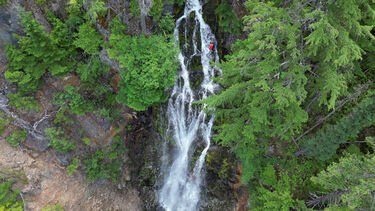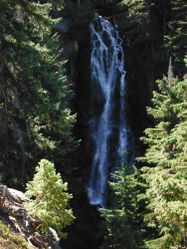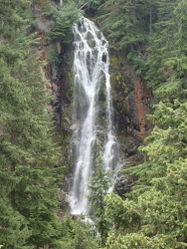Mesatchee Creek
| Rating: | |||||||||||||||||||||||||||||||
|---|---|---|---|---|---|---|---|---|---|---|---|---|---|---|---|---|---|---|---|---|---|---|---|---|---|---|---|---|---|---|---|
| | Raps:3-5, max ↨150ft
Red Tape: Shuttle:None Vehicle:Passenger | ||||||||||||||||||||||||||||||
| Start: | |||||||||||||||||||||||||||||||
| Parking: | |||||||||||||||||||||||||||||||
| Condition Reports: | 14 Aug 2025
"Great day in Mesatchee with many frog sightings. We did the short exit and I would NOT recommend this. There was lots of rock fall even though we went |
||||||||||||||||||||||||||||||
| Best season: | Jun-Aug
|
||||||||||||||||||||||||||||||
| Regions: | |||||||||||||||||||||||||||||||
Introduction[edit]
A significant tributary of the American River located east of Mt. Rainier National Park. It's a pretty canyon with surprisingly easy access and usually good flow even in the middle of summer. You do need to cross the American River on the approach and exit (wade or find a convenient log).
Water Flow[edit]
The waterflow checkpoint is from the trail lookout over to the main falls. If you do not feel comfortable rappelling in the waterfall it may still be ok to run the canyon, as there is a high water route on canyon left that allows you to rappel out of the water.
- Mesatchee Creek has a watershed of 2.58mi^2 and is north-facing. The highest point in the drainage is 6946ft high.
Approach[edit]
From Chinook Pass, head east 6.75mi to a signed trailhead for the creek. Drive in a short distance to the trailhead. Northwest Forest Pass (or America the Beautiful Pass) required.
From the trailhead, follow the well-established trail about 0.9mi to where it crosses Morse Creek on a bridge. Turn south, and arrive at a crossing of the American River (usually on a log) in another 0.2mi. River was knee deep in July 2024. Another 0.2mi ahead is a trail junction. Bear left here and head uphill another 0.5mi to a viewpoint of Mesatchee Falls. At about 0.5mi further, the trail levels out. Descend steep slopes to your right into the creek. If you reach a small stream crossing, you've gone farther than you need to.
- Special Note - if planning to take the scramble exit directly out from the bottom of the final rappel, it's recommended to leave a 50ft fixed handline anchored off a tree at 46.8941, -121.4132 down the steep gully. The scramble up is relatively easy until the final 50ft where it's thin and loose. Slipping here would likely entail a no-fun 200ft fall.
- (Unexplored) It might be feasible to head downstream maybe 50-100ft from the final falls to find an easy hike/scramble out DCR up to the trail. This exit looked lower angle and didn't look like a rope would be necessary.
Descent[edit]
The first rappel begins at about 4150ft elevation.
There appears to be a lot of loose, crumbling rock in Mesatchee. Use caution.
- R1: 25' cascade. Rappel from a tree DCR. Or easy 15’ downclimb on right. If downclimbing please stay in the channel and avoid harming the moss.
- R2: 75' from a tree DCR. The anchor is now a doubled canyon rope, and can be set over the rock so that the anchor manager can clip in and have line of sight to the rappel line. It may be worth tying an overhand on a bight at the end of the loop to create true redundancy.
- R3: 60’ from a tree DCL. There is a channel DCR at the bottom 20' be careful of foot entrapment.
- R4: 20' from a tree DCR. (Attempting to downclimb here not recommended per potential loose rock and minimal footholds. There has been an accident here.)
- R5: Mesatchee Falls - 150’ from a tree DCL in a pocket. The fall line right of center is smoothest and easiest. DCL is less in the flow but has a narrow channel and very bumpy making it high risk. The bottom 15’ is a downclimb. There is a small cave or mine at the base of the falls.
- If the big falls is running high, it's also possible to escape DCR from atop the falls. Ascend steep dirty slope to the ridge and few more steps to the trail.
Exit[edit]
There are two options for exiting:
- After R5, continue a few hundred feet downstream until you reach a prominent ridge DCR. Scramble up the ridge to the trail, being careful of loose rock and debris. If the climb up feels exposed, you're in the wrong place.
- Continue downstream less than 0.25mi. When the canyon opens up, reach a trail. Turn right and follow back to the American River.
Return to the trailhead the way you came. The river crossing provides a nice place to change and wash off gear.
Red tape[edit]
Northwest Forest Pass required for parking at the trailhead.
Mesatchee Creek is entirely within the William O. Douglas Wilderness Area.
Beta sites[edit]
 CanyoneeringNorthwest.com (archive.org) : Mesatchee Creek
CanyoneeringNorthwest.com (archive.org) : Mesatchee Creek
The main photo originated from Canyoneeringnorthwest.com. Additional photos can be found on their website.


